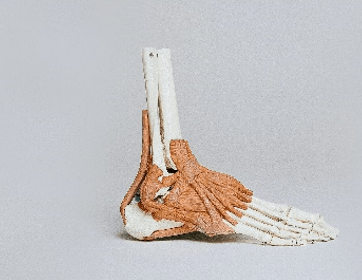3 Important Bones in Your Feet
The foot, which is comprised of the forefoot, midfoot, and hindfoot, relies on an intricate series of bones to offer stability and flexibility. Foot bones fall into three major categories; tarsal, metatarsal, and phalanges, which relate to the front, mid, and hind regions. Here’s an overview:
1. Tarsals
The tarsals are a group of seven irregularly shaped bones located proximally in the foot and ankle region. Tarsals are organized into proximal, intermediate, and distal rows. The proximal group comprises the talus and calcaneus. Talus transmits your body weight from the tibia to your heel bone, making it the most superior of all tarsal bones. The talus bones have ankle joint (superiorly), subtalar joint (inferiorly), and talonavicular joint (anteriorly) articulations.
Calcaneus proximal tarsal bones are the largest and lie underneath the talus. The bones have two articulations; subtalar and calcaneocuboid joints. Calcaneus bones also protrude posteriorly and take the body’s weight when the heel hits the ground. The intermediate row of tarsal bones contains the boat-shaped navicular bone. Navicular articulates posteriorly with the talus, anteriorly with the cuneiform bones, and laterally with the cuboid bone.
The distal tarsal bones comprise the cuboid and three cuneiform bones. Distal tarsal bones articulate with the metatarsals. The cuboid lies anterior to the calcaneus and is the furthest lateral bone. As the name suggests, it has a cuboidal shape. The three cuneiforms (medial, intermediate, and lateral) are wedge-shaped and articulate posteriorly with navicular and anteriorly with the metatarsals. Tarsal bones make up the rear section of your foot.
2. Metatarsals
The metatarsals comprise five tubular bones, one for each digit, located on the midfoot and forefoot area. Each metatarsal has a similar structure, dorsally convex with a neck, shaft, and base. Metatarsals occur between the tarsals and phalanges. The first metatarsal links to your big toe and is the shortest, thickest, and strongest. Your second metatarsal bone is the longest, and the rest get shorter as you move towards the pinky toe.
The metatarsal bone has three parts: the head, closest to your toes; the body, around the middle; and the base, nearest to the ankle. Each metatarsal bone articulates proximally to the tarsal bone. The first bone articulates to the medial and intermediate cuneiform bone, while the second (longest) metatarsal links to the three cuneiforms. Your third metatarsal articulates to the lateral cuneiform, and the fourth metatarsal connects to the lateral cuneiform and cuboid bones.
The fifth metatarsal links only to the cuboid bones. At Horizon Foot & Ankle Institute, we treat various metatarsal bone problems, including fractures common among athletes. Metatarsal bones are nearly parallel and provide structure to the body of the foot. They offer insertion points for lower limb and foot muscles and are a component of the arches. Your arch is important in force absorption and support. The arch is also a rigid lever for gait propulsion.
3. Phalanges
The phalanges are a group of small foot bones found in each toe. Note that the big toe has two phalanx bones, while the rest feature three phalanges. Phalanges can be proximal, intermediate (middle), or distal. The proximal phalanges are toe bones and articulate with the head of metatarsals at the metatarsophalangeal joints (MTP). Proximal phalanges are also the largest of all phalanges. Intermediate phalanges are small and occur in the middle of the toes.
Your big toe is the only one without an intermediate phalanx but features a distal phalanx. Distal phalanges are the toe bones furthest from the body. The different phalanges are connected using proximal interphalangeal joints (PIPs) and distal interphalangeal joints (DIPs). Toe phalanges allow the toes to bend correctly and support walking, running, jumping, and lateral movements. They also help you maintain balance when navigating irregular surfaces.
The phalanges of the toe can grip objects, more like the phalanges on your hand. The foot phalanges are shorter and better suited to walking and crawling. Phalanges injuries are common because the bones are not as dense. They can also suffer various ailments and deformities. At Horizon Foot & Ankle Institute, we can help you treat toe phalanx issues, including pain, deformities, and diseases. View our services to see everything we treat.
Working With a Foot Doctor
You may hurt the bones in your toes or experience peculiar symptoms like pain, lost sensation, and stubborn wounds. If you have an issue with your foot, ankle, or lower leg, Horizon is here to help. Our foot doctor can examine your issue to identify and treat the underlying condition. Our services span all pathology of the foot, ankle, and lower leg.
We treat major deformities of the foot and ankle, arthritis, pain, hammertoes, ingrown nails, diabetic care, skin conditions, and more. Horizon Foot & Ankle Institute can help you protect and treat the most important bones in your feet. We leverage advanced technology and conservative treatments to relieve symptoms and restore function.

